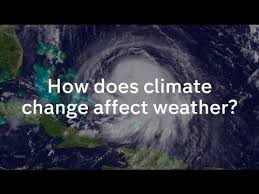The Connection Between Climate Change and Extreme Weather Events
In recent years, the discourse surrounding climate change has intensified, paralleled by a surge in extreme weather events globally. The fingerprints of climate change are becoming increasingly evident in our daily lives.

But what exactly is the connection between climate change and these extreme weather phenomena?
At its core, climate change refers to long-term alterations in temperature, precipitation patterns, and other atmospheric conditions due to human activities, notably the emission of greenhouse gases like carbon dioxide and methane. These emissions results in significant rise in global temperatures—a phenomenon commonly known as global warming.
The Global warming extend far beyond rising temperatures. They catalyze complex changes in atmospheric dynamics, giving rise to a cascade of extreme weather events.
Here’s how:
- Intensified Heatwaves: As global temperatures soar, heatwaves become more frequent, intense, and prolonged. High-pressure systems trap heat, exacerbating drought conditions and fueling wildfires.
- Heightened Storm Activity: Warmer oceans provide the energy necessary to fuel tropical storms and hurricanes, amplifying their intensity and rainfall. Rising sea levels exacerbate storm surges, leading to catastrophic flooding in coastal communities.
- Erratic Precipitation Patterns: Climate change disrupts traditional precipitation patterns, leading to both droughts and deluges. Prolonged droughts parch the land, imperiling agriculture and water supplies. Conversely, heavy rainfall events trigger flash floods and landslides, wreaking havoc on communities and infrastructure.
- Melting Ice Caps and Glacial Retreat: The accelerated melting of polar ice caps and glaciers contributes to sea-level rise, threatening coastal cities and island nations with inundation. The loss of reflective ice surfaces also amplifies global warming by reducing the Earth’s albedo, leading to further temperature increases.
- Shifts in Atmospheric Circulation: Climate change alters atmospheric circulation patterns, influencing the behavior of jet streams and weather fronts. These shifts can lead to prolonged periods of stagnant weather, exacerbating heatwaves or causing persistent precipitation in certain regions Governments, policymakers, and communities must prioritize efforts to reduce greenhouse gas emissions, transition to renewable energy sources, and implement resilient infrastructure and disaster preparedness measures.
In conclusion, the link between climate change and extreme weather events is undeniable. As we continue to witness the escalating frequency and severity of these events, it becomes increasingly imperative to confront the root causes of climate change and take decisive action to safeguard our planet and future generations.